Antifertility potential of leaves and seeds of Delonix regia in female rats
Garg Megha, Sharma Aditi, Choudhary Manjusha, Kaur Prabhjeet
Institute of Pharmaceutical Sciences, Kurukshetra University, Kurukshetra, India
ABSTRACT
Objective: To evaluate the antifertility activity of hydroalcoholic extract of Delonix regia (Boj. ex Hook.) Raf. leaves and seeds which are traditionally being used by Yanadi tribe to treat dysmenorrhea.
Methods: Three experimental animal models, including antiimplantation, early abortifacient, and estrogenic activity in female rats, were used for evaluation of the antifertility activity of both extracts at two dose levels (250 and 500 mg/kg, orally). There were five groups in the anti-implantation and early abortifacient activity while six groups in estrogenic activity including the standard. The number of implants, resorptions, vaginal cornification, body weight,uterus weight, and biochemical parameters were measured.
Results: At doses 250 and 500 mg/kg, the leaf extract was found to have strong anti-implantation action. The extract administered at the same doses also caused a significant rise in the number of resorptions, showing early abortifacient activity, increased uterine weight, and altered numerous biochemical parameters. Meanwhile,the seed extract only displayed slight anti-implantation activity at both levels.
Conclusions: Based on these preliminary findings, we can conclude that the leaf extract outperformed the seed extract in terms of antifertility activity, exhibiting potent estrogenic, anti-implantation and early abortifacient activities in a dose-dependent manner. These findings are consistent with the literature study and corroborate to the antifertility activity of the plant.
KEYWORDS: Delonix regia; Anti-implantation; Early abortifacient; Estrogenic; Gulmohar; Ovariectomy
Significance
The antifertility agents already available cannot be considered ideal contraceptives as they have potential side effects.Therefore, the search for the herbal sources possessing antifertility activity continues. Although the plant Delonix regia has several medicinal uses, there are no reports of its ability to prevent conception. This study is proposed to add another plant in the list of herbal antifertility agents having ethnomedicinal use. The study highlighted the efficacy of Delonix regia in regulating fertility, which may prove beneficial as smaller number of safe and effective medicines are available.
1. Introduction
Fertility has always been a matter of concern if we look at the escalating population so far. For the first time in the history of Homo sapiens, the world′s population surpassed one billion people at the start of the 19th century. The growth rates have been rising exponentially ever since, reaching unbelievable heights in the 20th century before lightly slowing down after that. Just after 2010, there were 7 billion people on the planet. By 2045, there will likely be 9 billion people. This will certainly not stop until the essential steps are taken. Results of this population explosion are increase in global poverty and famine, depletion and pollution of natural resources necessary for human survival[1].
The rate of fertility decides the growth of population of every country. Fertility rate can be defined as the mean of children that a woman gives birth during her lifetime. So, it can be hypothesized as a parameter for having an idea about the increase or decrease in the population. However, the fertility rate in the recent years 2019,2020 and 2021 so far has been 2.22, 2.20 and 2.17 births per woman respectively[2], which clearly indicates the decline in the trend, but despite this, still it is a matter of substantial consideration to have a check on the exploding population. This growing population unsympathetically affects the mankind in several ways; may it be socially, economically or in the technological development[3].
To reduce the chances of fertilization and in some cases unwanted conceptions, many contraceptive methods have been developed including oral pills, implants, injections, patches, vaginal rings and even permanent methods like tubectomy (females) and vasectomy(males). The most prominent and widely used techniques among these are the ‘oral contraceptive pills’. These are available in different combinations e.g., progestin-only pills (minipills),combined oral contraceptive pills (mala-N), emergency contraceptive pills (containing levonorgestrel) and Centchroman (ormeloxifene)[4].
These synthetic drugs seem to pose various side effects such as irregular and unexpected bleeding, headache, nausea or dizziness,breast tenderness, weight changes, mood changes, acne, etc[4]. So,people are switching towards herbal antifertility drugs which have been used traditionally by our ancestors from many years. Traditional medicine is frequently chosen because it is more affordable, more in accordance with the patient′s philosophy, all as concerns about the negative effects of chemical (synthetic) treatments, meets a need for more personalized health care, and increases public access to health information[5]. Whether people have physical or financial access to allopathic treatment, traditional medicine offers an essential health care service, and it is a thriving global economic industry[6]. About 25% of prescriptions in today’s system of medicine contain active principles derived from plants as they are easily available[7].
In order to have a check over the rising population and to increase the choices, the search for novel antifertility compounds in natural sources is incessant. There are numerous plants that are said to have fertility-regulating properties, out of which many have been reported to show such effects but there is a lot more to explore in this field so as to develop a potent antifertility agent.
Delonix regia (Boj. ex Hook.) Raf. belonging to family Fabaceae is generally referred to as royal poinciana or flame tree. The tree is native to Madagascar and is now spread widely in most subtropical and tropical areas of the world and has been planted more extensively as a garden and avenue tree in both moist and dry regions of tropical India.
Gulmohar is a flowering ornamental tree that grows to a height of 10 to 15 meters[8]. Many parts have historically been used to cure a range of conditions, including fever, gynaecological issues, rheumatism, bronchitis, diabetes, anaemia, antifertility, and pneumonia. Additionally, the plant has anti-inflammatory, analgesic,anti-diarrheal, anti-hemolytic, gastro protective, wound healing,larvicidal, anti-malarial, antiemetic, antioxidant, hepato protective,gastro protective, anti-arthritic, and anthelmintic properties[9].Dysmenorrhea is traditionally treated using flowers from the Delonix regia plant by the Yanadi tribe in Andhra Pradesh, India[10].Scientifically, anti-spermatogenic activity of methanol extract of Citrullus colocynthis and Delonix regia on male reproductive organs of Wistar rats[7] has already been proven and antifertility activity of seeds of Delonix regia has been proved in Musca domestica[6]. There is currently no relevant evidence supporting significance of the plant in female fertility management. Therefore, the present study was designed.
This study was planned for evaluation of early abortifacient, antiimplantation, and estrogenic activity of Delonix regia leaves and seeds in female rats on the basis of chemical constituents present.
2. Materials and methods
2.1. Plant collection and extract preparation
Fresh leaves and seeds of Delonix regia were collected from road side and were authenticated by Raw Materials Herbarium and Museum, Delhi (RHMD), CSIR-NISCAIR, with authentication No. (NISCAIR/RHMD/Consult/2022/4016-17). After air drying the leaves and seeds for one week, 430 g of dried coarsely grinded leaves and 300 g of seeds were extracted with hydroalcoholic solvent(30:70) using Soxhlet for 72 h at a temperature of 50 ℃. The yield of leaf and seed extract was 26.97% w/w and 12 % w/w, respectively.The extracts were stored in a refrigerator at 4 ℃ for future use.
2.2. Preliminary phytochemical screening
Preliminary phytochemical screening was carried out in accordance with the standard methods described in practical pharmacognosy by Kokate[11] and Khandelwal[12].
2.3. Animals
Healthy Wistar, reproductive male and female rats with proven fertility weighing 150-200 g were used for the present research work. The animals were acquired from Lala Lajpat Rai University of Veterinary and Animal Sciences, Hisar, and were housed under controlled laboratory conditions [(20-22) ℃ temperature, 60% humidity, and a 12-hour light/dark cycle]. After acclimatizing the animals for a week, they were given free access to food and water.
2.4. Vaginal smear detection
The phases of estrous cycle of each rat used for the study of antiimplantation and early abortifacient activity were determined by observing vaginal smear daily between 9 to 10 a.m. Vaginal smear was prepared by introducing 0.3-0.5 mL of normal saline into vagina with the help of a dropper, collecting back and placing it on a clean slide. The prepared smear was examined microscopically. Female rats, which were recorded at least two sequential regular estrus cycles, were used for experimentation. There are four phases in the estrous cycle of female rats. If majority of cells are leucocytes, then it was labeled as in diestrus phase. The presence of large number of nucleated cells was indicated the proestrus phase. More than 50% cornified epithelial cells were identified as estrous phase. Meta estrous phase was indicated by the presence of many neutrophils and scattered squamous epithelial cells in the smear[13].
2.5. Anti-implantation and early abortifacient activity in rats
2.5.1. Study design
There were a total of 30 animals divided into five groups, out of which animals of four groups received the treatment, and another one was kept as the control. All the groups were identical in behavior as well physiology (Figure 1).
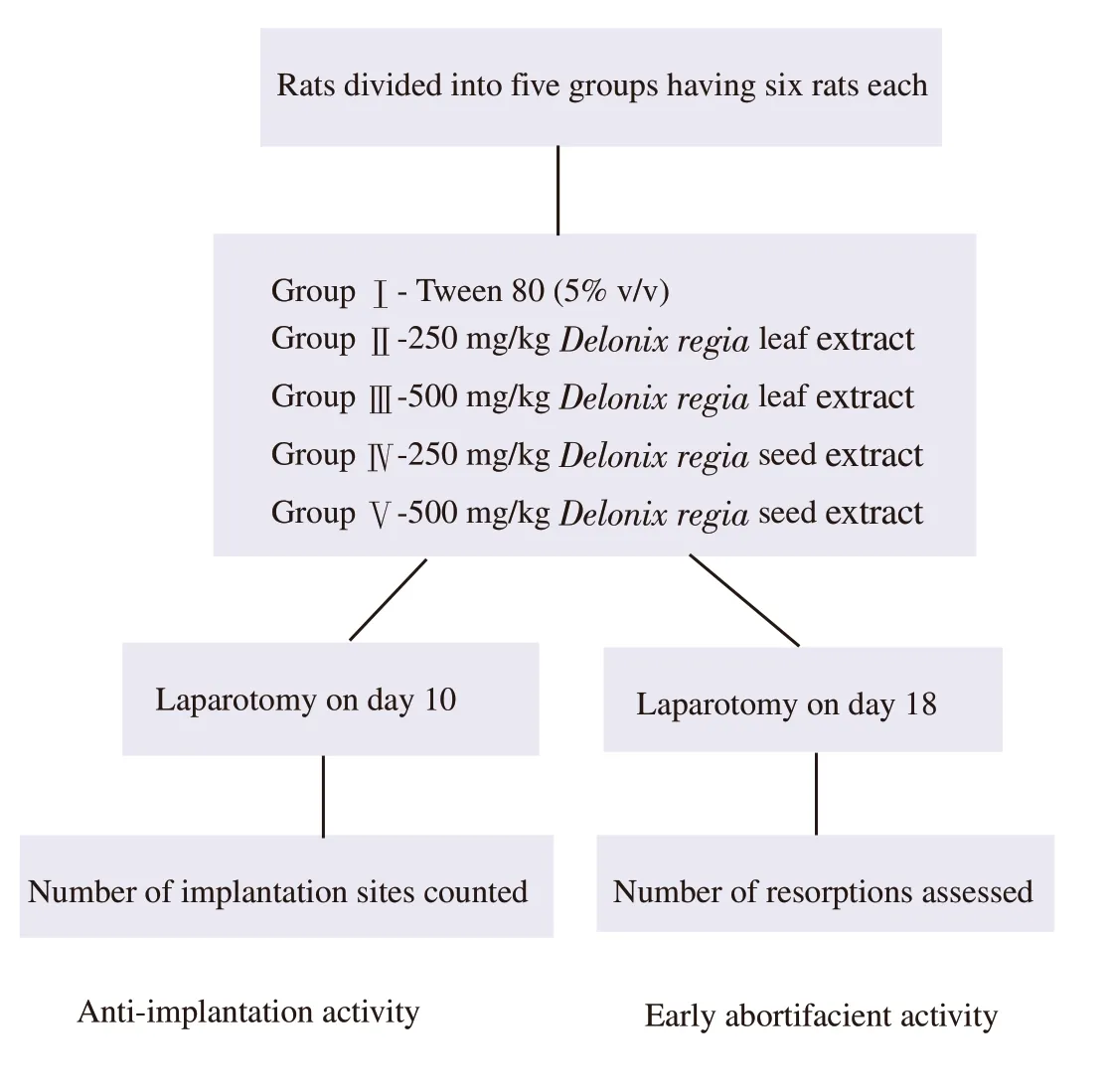
Figure 1. Schematic diagram of experimental design for antifertility activity.
2.5.2. Experimental procedures
For anti-implantation and early abortifacient activities of plant extracts, adult female Wistar rats weighing 150-200 g were employed. The vaginal smear of each rat was observed everyday while it was adjusting to its new environment. The study included the female rats with healthy estrous cycles. Female rats in the proestrus period were housed with fertile male rats (ratio 2 : 1). On the next morning, female rats were examined for signs of copulation.The animal exhibiting thick clumps of spermatozoa in vaginal smear were separated from male partners. The day spermatozoa were detected in the vaginal smear was considered as day 1 of gestation.The separated pregnant rats were divided into five groups of six rats each. Group Ⅰ served as vehicle control and received 5% v/v Tween 80; group Ⅱ and group Ⅲ animals received hydroalcoholic leaf extract of Delonix regia at doses of 250 and 500 mg/kg, respectively.Animals from group Ⅳ and Ⅴ received hydroalcoholic seed extract of Delonix regia at the same doses[14]. Doses were selected on the basis of literature survey showing acute toxicity studies of Delonix regia which showed that it is safe up to dose of 5 000 mg/kg[15]. The extracts were given orally from day 1 to the day 9 of pregnancy[14].On day 10, laparotomy was performed in sterile conditions with light ether anesthesia. The number of implantation sites in the uteri were counted, and the number of corpora lutea in the ovaries were noted.The animals were placed in cages after suturing their abdomen.Treatment with extract again started on day 11 and continued till day 16, orally. Laparotomy was performed again on day 18 for assessing the early abortifacient action.
Formulas 1 and 2 were used to calculate the percentages of antiimplantation and early abortifacient activity, respectively. The percentage anti-fertility activity of the extracts was determined by adding the anti-implantation and early abortifacient effects(formula 3).
Formula 1:
Formula 2:
Formula 3:
2.6. Estrogenic activity
2.6.1. Study design
There were a total of 36 animals divided into 6 groups having 6 animals each. GroupⅠ was treated with vehicle only i.e., Tween 80(5% v/v). Standard drug (ethinyl estradiol) treatment was given to animals of group Ⅱ, whereas Groups Ⅲ to Ⅵ were treated with test extracts of leaves and seeds of Delonix regia (Figure 2).
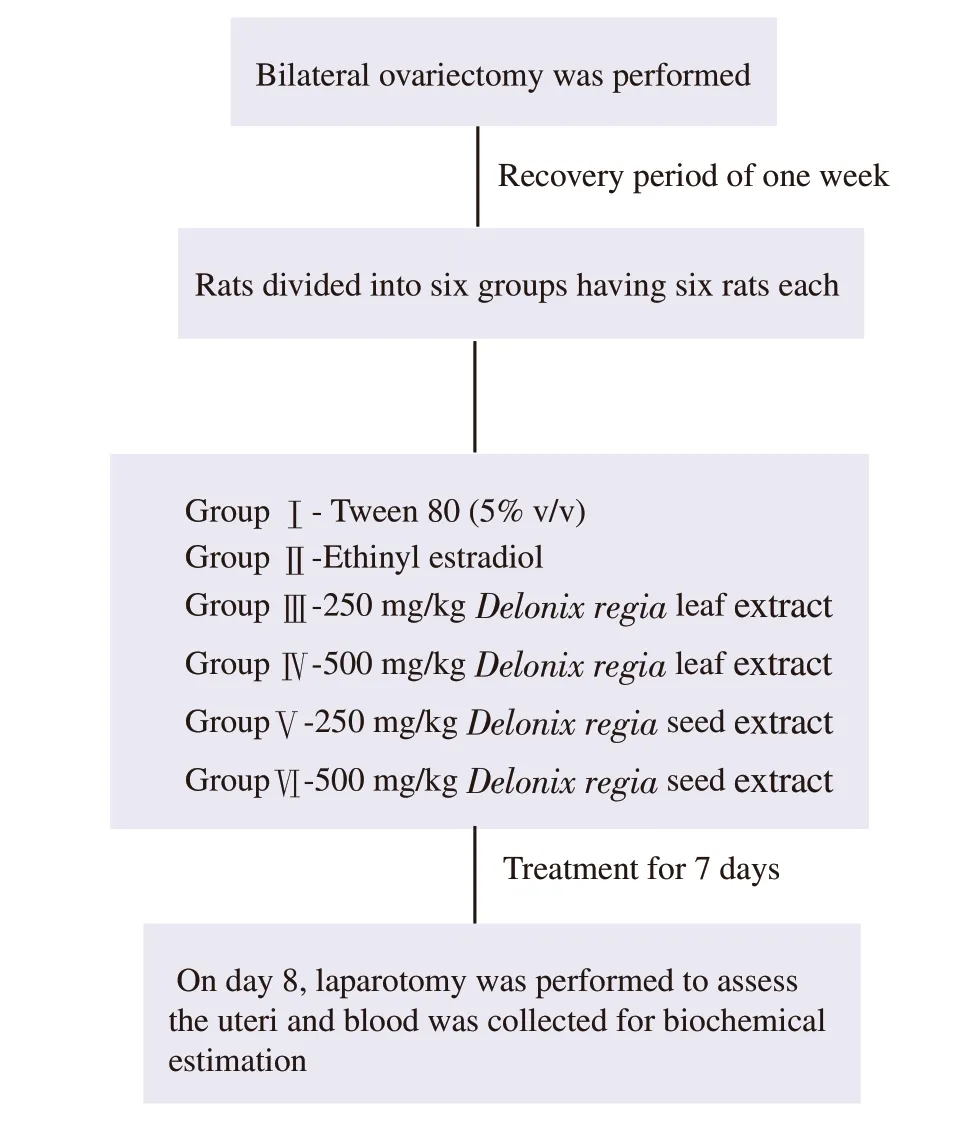
Figure 2. Schematic diagram of experimental design for estrogenic activity.
2.6.2. Experimental procedure
Under light ether anesthesia and in semi-sterile environment,female rats were weighed and had their bilateral ovaries removed.After one week, they were separated into 6 groups of 6 animals.GroupⅠserved as vehicle control group (Tween-80, 5% v/v).Group Ⅱ received the standard drug (ethinyl estradiol) suspended in olive oil. Leaf extract was administered to groups Ⅲ and Ⅳ, at dosages 250 and 500 mg/kg, respectively, and animals of groupsⅤ and Ⅵ received 250 and 500 mg/kg doses of seed extracts over the course of seven days. The final body weight of each animal was measured on the eighth day. Then, all the animals were sacrificed while being lightly sedated with ether and biochemical parameters were estimated[16,17]. These parameters included total protein,triglycerides, cholesterol, alkaline phosphatase, estradiol level, body weight gain, uterine weight. The total protein test measured the total amount albumin and globulin in the body. Serum cholesterol level comprises the amount of high-density lipoprotein (HDL), lowdensity lipoprotein (LDL), and triglycerides in the blood. Absence or reduction in the level of the same in the endometrium is one of the causes of conception control. Estradiol levels indicate the amount of estrogen hormone in the systemic circulation.
2.7. Statistical analysis
The software which was used for the statistical analysis is GraphPad InStat Version 3.06, 32 bit for windows. All the data were expressed as mean±standard deviation (mean±SD). The data of each experimental group were analyzed using one-way analysis of variance (ANOVA) followed by Dunnett’s test. The levels of significance were taken at P<0.05 in comparison to the control group.
2.8. Ethics statement
The study received approval from Institutional Animal Ethical Committee (IAEC) with protocol number IPS/IAEC/322,326/22,and adhered to the guidelines by the Committee for the Purpose of Control and Supervision of Experiments on Animals (CPCSEA),Ministry of Environment, Government of India, New Delhi (Reg.No.562/GO/Re/S/02/CPCSEA).
3. Results
3.1. Phytochemical screening
Preliminary phytochemical screening of leaves of Delonix regia revealed the presence of alkaloids, cardiac glycosides, flavonoids,tannins, phytosterols, reducing sugar, protein, and amino acid(Supplementary Table 1).
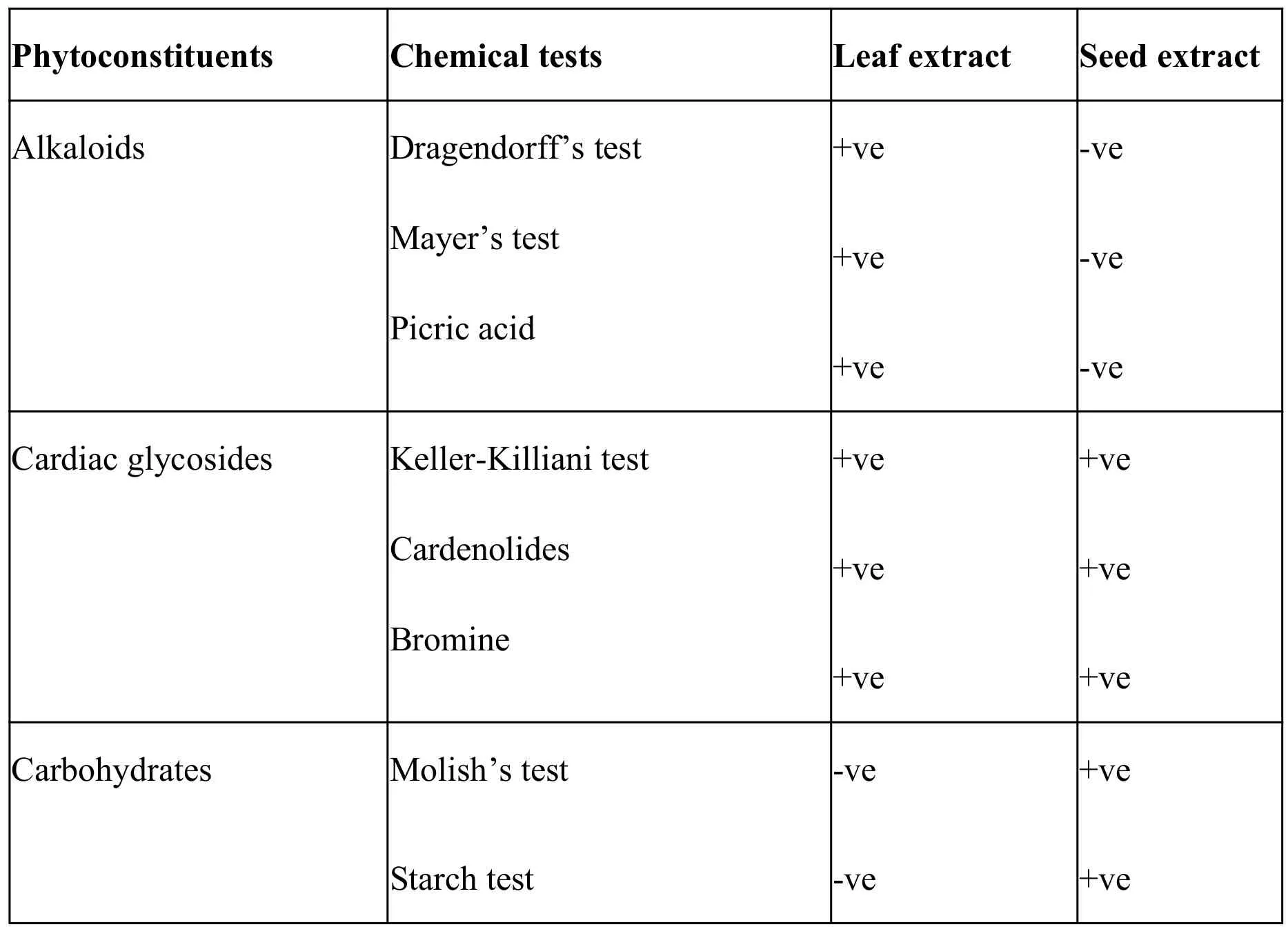
Supplementary Table 1.Preliminary qualitative phytochemical screening of leaf and seed extract of Delonix regia.
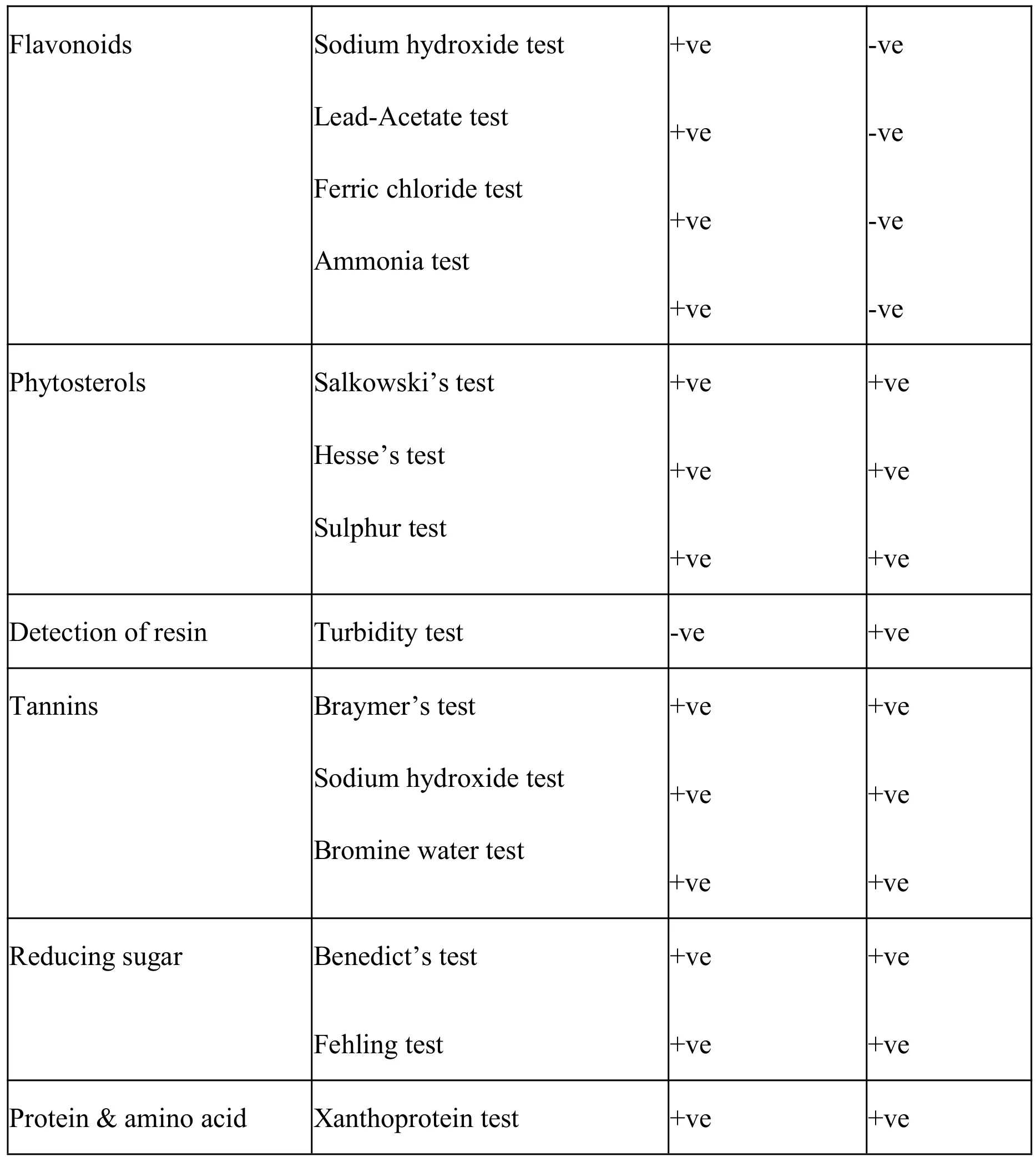
+ve indicates presence;-ve indicates absence.
3.2. Antifertility activity
In the present study, the anti-fertility activity of the extracts was evaluated using two experimental animal models, anti-implantation,and early abortifacient activity of Delonix regia leaves and seeds at doses of 250 and 500 mg/kg was performed in female Wistar rats.The number of implants and resorption were compared to the vehicle group (Table 1)

Table 1. Effect of hydroalcoholic leaf extract and seed extract of Delonix regia on implants and resorption index in female rats.
3.2.1. Anti-implantation activity
Anti-implantation activity is expressed as a percentage decrease in the number of implantations in the uteri on day 10 of pregnancy.At 250 and 500 mg/kg dose, hydroalcoholic extract of Delonix regia leaves demonstrated highly significant anti-implantation activity when compared with the control group, while the seed extract displayed less significant anti-implantation activity at both the doses of 250 and 500 mg/kg. The extract showed a notable dose dependent action as depicted by the marked decrease in the number of implantation sites observed with increase in the dose.
3.2.2. Early abortifacient activity
Early abortifacient activity is expressed as several resorbed implants from the existing number of implants were recorded on day 18, to evaluate the early abortifacient activity. At a dose of 500 mg/kg, the leaf extract of Delonix regia decreased the number of viable fetus and increased the number of resorptions, whereas at a dose of 250 mg/kg,less resorption was seen. However, on day 18, the seed extract at the doses of 250 and 500 mg/kg did not cause resorption, this means that neither of the doses of seed extract exhibited any early abortifacient action.
3.2.3. Antifertility activity
The hydroalcoholic extract of leaves of Delonix regia showed 50.86% and 66.66% antifertility activity at dose of 250 and 500 mg/kg, respectively, whereas the hydroalcoholic extract of seeds of Delonix regia extract showed 18.12% and 16.37% antifertility activity at dose of 250 and 500 mg/kg, respectively (Table 2).

Table 2. Antifertility effect of hydroalcoholic leaf extract and seed extract of Delonix regia in female rats.
3.3. Estrogenic activity
3.3.1. Vaginal effects
The vaginal smears of most of the rats revealed the presence of a vaginal opening and cornified cells. The presence of cornified cells was considerably higher in the leaves treatment group as compared to the vehicle group.
3.3.2. Physical parameters
The estrogenic effect of hydroalcoholic extract on uterine weight,diameter in mature ovariectomized rats is shown in Table 3. When compared to the standard group, the effects of the leaf extract on uterine weight were significant at 250 mg/kg (P<0.01). The leaf extract at both doses remarkably increased the uterine diameter,whereas seed extract displayed significant increase in uterine weight only (Table 3).

Table 3. Effect of hydroalcoholic leaf extract and seed extract of Delonix regia on uterus for estrogenic activity in female rats.
The findings suggest that the ethinyl estradiol treatment group showed a mean body weight gain of 25 g, which was significantly higher than the 10.83 g observed in the ovariectomized vehicle control group. At the dose of 500 mg/kg, the leaf extract showed notable body weight gain (Table 4).

Table 4. Effect of hydroalcoholic leaf extract and seed extract of Delonix regia on body weight.
3.3.3. Effect on biochemical parameters
In all the groups, total protein levels were significantly higher than the vehicle group, although the effects of leaf extract at dose 500 mg/kg were the most significant. However, seeds at both doses (250 and 500 mg/kg) and leaves at 250 mg/kg demonstrated an increase in the total protein level. The levels of cholesterol,triglycerides, alkaline phosphatase, and estrogen in the blood serum of the extract-treated animals shown significant results (P<0.01) as compared to the vehicle when leaf extract (500 mg/kg) was used as the vehicle. However, the standard group animals showed a greater change in the levels of these parameters. Little estrogenic effects were also detectable at a dosage of 250 mg/kg of leaf extract(Table 5).

Table 5. Effect of hydroalcoholic leaf extract and seed extract of Delonix regia on biochemical parameters for estrogenic activity in female rats.
4. Discussion
In the modern world, there are many strategies for controlling fertility, but none of them can be regarded as the optimal method because each method has advantages and disadvantages[18]. People nowadays are moving towards herbal medicines due to the fact that Asian continent is home to numerous medicinal herbs. In this regard, the current study was designed. In this study, phytochemical screening was performed to identify the type of constituents present.Phytochemical literature review conducted on Delonix regia also revealed the presence of flavonoids, phenolic compounds, fatty acids, tannins, etc.[19]. The anti-implantation and early abortifacient activity were done to assess the anti-fertility potential of Delonix regia and revealed that the leaf extract exhibited anti-implantation, early abortifacient as well as estrogenic activity while the seed extract only showed anti-implantation activity and mild estrogenic activity.
The anti-implantation activity was expressed as the percentage decrease in the number of implantations in the uteri on day 10 of pregnancy while the number of resorbed implants from existing number of implants was recorded on day 18 for evaluating the early abortifacient activity. At 250 and 500 mg/kg dose, hydroalcoholic extract of Delonix regia leaves demonstrated highly significant antiimplantation activity. At a dose of 500 mg/kg, the leaves of Delonix regia decreased the number of viable fetus and increased the number of resorptions, whereas at a dose of 250 mg/kg, less resorption was seen. At the doses of 250 and 500 mg/kg, the seed extract exhibited decreased anti-implantation activity; however, on day 18, none of the doses of seed extract caused resorptions. The potential reason for pregnancy termination after oral administration of plant extract may be due to anti-zygotic, anti-blastocytic action or killing the preborn child shortly after implantation[20].
The leaf and seed extract at the dose 500 mg/kg increased the level of estrogen comparable to ethinyl estradiol, exhibiting the estrogenic properties. Additionally, there was a significant increase in other biochemical parameters such as total protein, serum cholesterol,serum triglycerides, HDL cholesterol and alkaline phosphatase. The female genitalia and the uterus undergo multifarious physiological and biochemical changes due to the presence of ovarian hormones such as estrogen[21]. In the female rats, deficiency of estrogen resulted in the atrophy of the uterus and reproductive tract. On the other hand, administrating estrogenic substance to ovariectomized rats causes uterotrophic effects, vaginal cornification, and other alterations in the biochemical parameters. Estrogenic substances may not only disrupt the functional equilibrium between the endogenous estrogen and progesterone but also cause the expulsion of ova from the fallopian tube which may result in failure in fertility. Definite hormonal balance, namely between estrogen and progesterone, is required for the implantation of ovaries in uterine walls and the maintenance of pregnancy because an imbalance in these hormones can lead to abortion[22]. The compounds estrogenic in nature lead to the keratinization and cornification of cells in vaginal epithelium,which causes superficial cells to be shed into the lumen forming large squamous cells[23]. Dose dependent increase in percentage vaginal cornification is shown by the hydroalcoholic extract of Delonix regia. The evaluation of estrogenic activity of the plant extract depicted that it can replicate the effects of hormone estrogen as it increased body weight, uterine weight, caused vaginal opening and increase in the biochemical parameters.
The hormonal milieu in the uterus is typically disturbed by substances of hormonal relevance, which intensifies an antifertility action. Since estrogens are known to promote uterine contractibility to eject a fertilized egg, the estrogenic action may be due to a mechanism by which the abortifacient effects of extract are mediated[17]. Phytoestrogens, which have affinity with both estrogen receptors alpha and beta, prefer the more newly identified estrogen receptor beta. They closely resemble the mammalian estrogen estradiol, structurally. Fruits, vegetables and whole grains that are frequently consumed by people are known to contain phytoestrogens[24]. Soy, red clover, kudzu, hops, licorice, rhubarb,yam, and chaste-berry are examples of plant extracts with putative estrogenic properties[25]. Steroids, flavonoids, alkaloids and phenolics, which are found in several plants, have already been demonstrated to have anti-fertility effects on laboratory animals[18].The flavonoids present in Striga lutea and Striga orobanchioides were highly estrogenic and had antifertility effects[26,27]. Flavonoids and phenolic compounds are known to possess estrogenic activity. The flavonoids, phytosterols and phenolic compounds present in the extract may be responsible for significant antifertility activity against the selected animal models.
Moreover, this study has some limitations, for example,quantification and isolation could be done and early abortifacient activity was studied instead of abortifacient activity.
In conclusion, at doses 250 and 500 mg/kg, the leaf extract is found to have better antifertility activity than the seed extract. At both doses, the leaf extract shows significant increase in the number of resorptions which signifies early abortifacient activity of the plant. Moreover, increased uterine weight and alteration of various biochemical parameters are also observed. This plant, in general,may further be investigated for detailed antifertility activities especially at higher doses and the active constituents can also be identified.
Conflict of interest statement
We declare that we have no conflict of interest.
Acknowledgement
The authors are highly thankful to Kurukshetra University,Kurukshetra for providing essential facilities to carry out this research work.
Funding
This study received no extramural funding.
Authors’ contributions
Garg Megha and Sharma Aditi conducted literature study,experimental studies, data acquisition, and manuscript preparation.Choudhary Manjusha carried out supervision, concept, design, data analysis, statistical analysis, manuscript editing, and manuscript review. Kaur Prabhjeet performed statistical analysis and manuscript review.
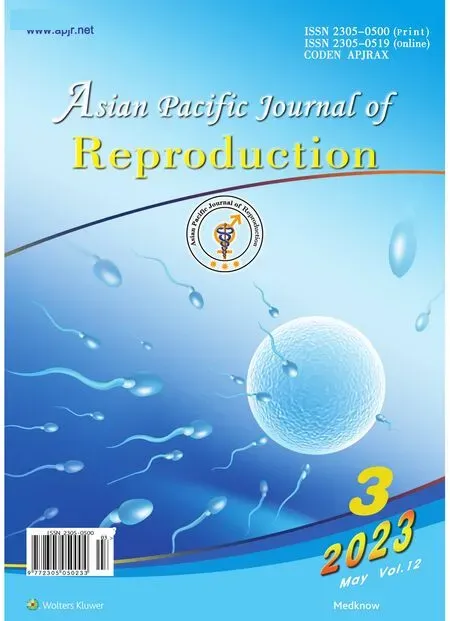 Asian Pacific Journal of Reproduction2023年3期
Asian Pacific Journal of Reproduction2023年3期
- Asian Pacific Journal of Reproduction的其它文章
- Do not lose the moon while counting the stars: Conventional IVF versus add-on treatments
- Prevalence and risk factors of infertility in a Mongolian population
- Protein kinase inhibitors affect spermatogenic functions and blood testis barrier remodelling: A scoping review
- Buffalo anti-PDC-109 antibodies improve the semen quality profiles and in-vitro zona binding index and minimize the cryoinjury of sperm in cryopreserved buffalo semen
- Effects of a glyphosate-based herbicide on the oestrous cycle of rats
